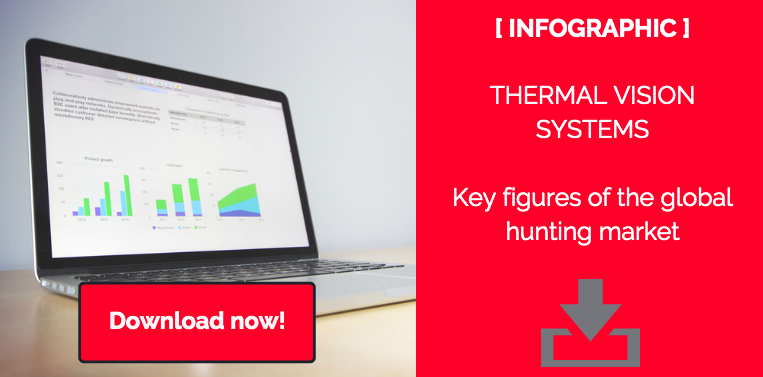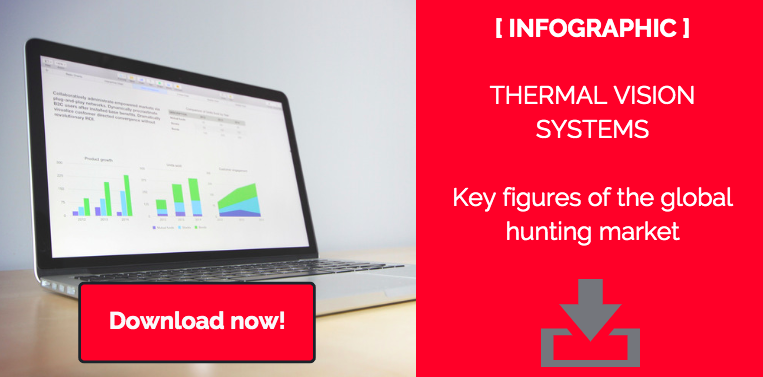Precision Thermal Imaging for Hunting & Leisure: Premium European Solutions for ...
The Hunting & Leisure market is evolving—driven by advanced technology, changing regulations, and the expectations of a new generation of responsible hunters...

September 04, 2019 . 5min read
The hunting market is growing both in Europe—with high potential in Russia, the Czech Republic, and Slovenia, for example—and in the United States. Thermal imaging’s capacity to enhance the performance of hunting gear like viewfinders, monoculars, and clip-on vision equipment through advanced night vision technology (image intensifiers) will create substantial opportunities on this increasingly high-tech market.
Unlike conventional night vision systems, thermal cameras do not need light to produce an image. As soon as an animal moves, the heat it gives off makes it visible, even in total darkness and in virtually all weather. The ability to see animals during the day and at night by detecting the tiny differences in the heat given off by different objects in a scene makes the technology very attractive to hunters.
Read on to learn how thermal imaging can benefit the hunting market and vice-versa.
Hunting is more than a hobby; it has become a lifestyle for growing numbers of enthusiasts. Today, more than 6.7 million people in Europe hunt, and the market is worth €16 billion per year. In the United States, hunting is one of the most popular hobbies around, with more than 11 million enthusiasts driving a $26 billion market.
The hunting market is growing at a particularly fast pace in Eastern Europe. In Russia, the activity is part of the nation’s identity. More free time, greater interest in the outdoors (the development of outdoor infrastructure, counting game populations, etc.), and growing concern about controlling undesirable species are just some of the factors fueling the growth of the hunting industry.
The market for thermal imaging as a tool to detect game is currently occupied by around 60 companies. The main products sold on this market are viewfinders (35%), monoculars (51%), and clip-ons (14%). Half of the thermal sensors are QVGA (384 x 288) and 38% are VGA (640 x 480).

Thermal imaging sensors offer excellent value for activities like observing wildlife or hunting. Hunters are particularly demanding and want superior image quality and a long detection range (from 10 meters to 300 meters). While hunters are starting to use thermal imaging to detect game, the use of night vision is still much more common. Each technology has its own advantages and disadvantages.
Thermal imaging | Night vision |
+ | + |
Long detection range | Realistic image with good resolution |
Effective in wooded areas | See details on animals |
Good image in fog or heavy rain | See game in detail at long ranges |
Not sensitive to daylight | Higher optical magnification |
Does not require an additional light source | Battery life up 50 hours |
- | - |
Hard to see game in detail at long ranges | Additional light source often needed |
Vs identification | Detection difficult at long ranges |
| Poor image quality in fog or heavy rain |
| Sensitive to daylight |
Regardless of where you are in the world, hunting is a strictly regulated activity. However, from hunting season start and end dates to whether or not night hunting is allowed, the regulations vary from one country to another. For professionals in the hunting industry, import/export rules also vary. In addition, in some places it may even be illegal to possess an item that is allowed elsewhere. For example, in Iceland, night vision systems are legal, but their use for hunting is prohibited. In France, hand-held night vision systems are authorized, but systems that must be mounted on a headset or rifle are not.
Night hunting is prohibited in most countries in Europe. However, there are exceptions, especially to regulate undesirable species like wild boar, which do a lot of damage. In 2016, damage caused by such species was estimated at €50 million in France alone.
The hunting market offers high potential for thermal imaging. The pace of technology development is fast, and, as new products are released on the market, new uses will emerge.
